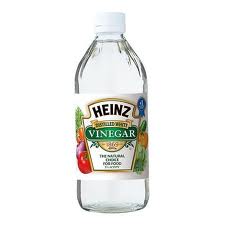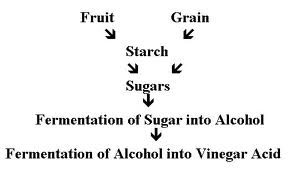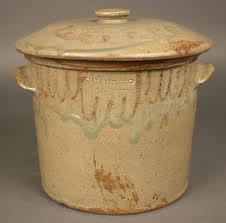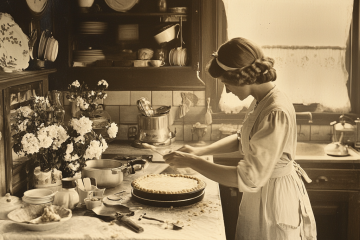Every time the hubster goes out to pick up something at the store he’ll ask me “Do you need anything?” My response is typically “just the basics.” In our household “the basics” always includes white vinegar. (and butter, just in case you’re curious)
 I gotta tell you. Sometimes I’m just as grateful for the gift of vinegar as I am a beautiful sunrise. I can use it medicinally, to clean without the chemicals, to preserve foods, and to season. It’s also a GREAT weed control too. As soon as I find it in 5 gallon drums I’m likely to buy some. Hee hee But, anytime I find myself “loving” something that much, I have this crazy instinct which prevents me from fully enjoying something unless I’m able to answer the question “how can I create this from scratch?” (I’ll never be held hostage by Hostess again! That was just too traumatic. *grin*) I’m talking about making real vinegar made from scratch, not that flavored vinegar that you make from leftover wine.
I gotta tell you. Sometimes I’m just as grateful for the gift of vinegar as I am a beautiful sunrise. I can use it medicinally, to clean without the chemicals, to preserve foods, and to season. It’s also a GREAT weed control too. As soon as I find it in 5 gallon drums I’m likely to buy some. Hee hee But, anytime I find myself “loving” something that much, I have this crazy instinct which prevents me from fully enjoying something unless I’m able to answer the question “how can I create this from scratch?” (I’ll never be held hostage by Hostess again! That was just too traumatic. *grin*) I’m talking about making real vinegar made from scratch, not that flavored vinegar that you make from leftover wine.
Soooo, just in case there are any other crazy people like myself out there who have embraced the virtues of vinegar I thought I’d try and save you from doing without someday by turning you on to the fact that yes, you can make your own vinegar from scratch. You can make malt vinegar, balsamic vinegar, apple cider vinegar, red wine vinegar, and just plain white vinegar. Frankly, there’s just an awesome amount of peace that I get knowing that I don’t have to rely on transportation, electricity, or Heinz to run a profitable business. I love knowing that “I do it my-seff”, as my adorable niece used to say. And so can YOU.
What I’d like to accomplish today is A) The encouragement to venture into this fun activity so you can enjoy chemical free cleaning, medicinal benefits, culinary craftsmanship, and a little lawn care. B) Provide you with the basics that you’ll need on hand that you can obtain now just in case you’re inclined to put off learning how to make vinegar for now but still want to make sure that you at least have all of the necessary supplies.
 Fortunately, you’ll find this process relatively simple. Time is your friend mixed in with the occasional, brief tending steps. The vinegar making process uses the similar fermentation process as used in winemaking—in fact, technically speaking, you’ll pass the “wine” stage by the time youget to the finished vinegar product. This is why you’ll find that the “cooking wines” offered commercially strongly resemble the smell of flavored vinegars. It’s also why I giggle a little bit when I have friends who are horrified when I use a little cooking wine in my cooking. If they only knew that a finished dish that uses wine in it has the same finished result that you get when you use vinegar. The alcohol is burned off in cooking and it ferments out during the vinegar making process. The key flavor that you end up with in the vinegar making process is the acetic acid. (ranging from 5 to 18%) tartaric acid and citric acid.
Fortunately, you’ll find this process relatively simple. Time is your friend mixed in with the occasional, brief tending steps. The vinegar making process uses the similar fermentation process as used in winemaking—in fact, technically speaking, you’ll pass the “wine” stage by the time youget to the finished vinegar product. This is why you’ll find that the “cooking wines” offered commercially strongly resemble the smell of flavored vinegars. It’s also why I giggle a little bit when I have friends who are horrified when I use a little cooking wine in my cooking. If they only knew that a finished dish that uses wine in it has the same finished result that you get when you use vinegar. The alcohol is burned off in cooking and it ferments out during the vinegar making process. The key flavor that you end up with in the vinegar making process is the acetic acid. (ranging from 5 to 18%) tartaric acid and citric acid.
Now let’s talk a little bit about the process. First, understand that you’ll begin with an alcohol base. (Technically I believe it’s actually ethanol which is a grain alcohol, but all of the instructions that I’ve ever used refer to it as alcohol—so I apologize for any confusion I might cause by using the term “alcohol.”) You will be creating a specific type of vinegar based on the bacteria that you introduce into the alcohol base. It’s this “mother bacteria” or “mother vinegar” that will transform the alcohol into vinegar through the fermentation process. Don’t panic about the alcohol base. It’s simple and inexpensive to create from nature in a myriad of different ways. If it wasn’t, there would be very few moonshiners. *grin* All you need for alcohol is fruit and sugar. When I first discovered this I got crazy looks from my friends when I asked them for their apple scraps or peach and apricot scraps. You don’t need the whole fruit. The scraps of the fruit will suit your alcohol making needs just fine. You can find “mother vinegar” online actually. (I’m presently waiting anxiously for my malt vinegar mother bacteria to arrive. I can’t believe I just wrote that, let alone felt the excitement as I did. Good grief. What’s become of me?)
Some more key things I’ve learned are a MUST when it comes to making vinegar include the necessity of having a super clean workspace. You need to be very careful to avoid introducing any bacteria into your process that you don’t purposefully want. It does seem a bit ironic to me because vinegar is oft times used as a healthy disinfectant. (That’s why sipping on warm vinegar water kills the bacteria in a sore throat.) But I guess you’ve got to raise the vinegar up right to have a healthy respect for bacteria. *grin*
 Next, don’t make the mistake of using any metal instruments in your vinegar making process. I prefer a 2 gallon, wide mouth clay crock. (Minehas a spigot on it). You’ll want it wide-mouth so that you can tend to the fermentation process unencumbered. If it were me, I’d even stay away from stainless steel and cast iron. I’ve had something go wrong every time I use anything remotely metal. So stick to clay, glass, or ceramic. You could even use a wine barrel like they used to eons ago.
Next, don’t make the mistake of using any metal instruments in your vinegar making process. I prefer a 2 gallon, wide mouth clay crock. (Minehas a spigot on it). You’ll want it wide-mouth so that you can tend to the fermentation process unencumbered. If it were me, I’d even stay away from stainless steel and cast iron. I’ve had something go wrong every time I use anything remotely metal. So stick to clay, glass, or ceramic. You could even use a wine barrel like they used to eons ago.
Next, stock up on that sugar; it’s critical to creating your alcohol. Most people look at my sugar stash and think that I just plan on having a sweet tooth through years of thick and thin, but in actuality I look at my sugar stash as my vinegar stash. You could also stock up on sugar beet seeds and make sugar from the sugar beets, but you can actually cut some corners and make alcohol directly from the sugar beets by using a fermentation process, but that’s a whole ‘nother story.
You’ll also want to make sure you have plenty of cheesecloth. Straining and squeezing is a common part of making vinegar (and a myriad of other nutritionally valued foods). I purchase my cheesecloth by the yard online. I like to have a fine mesh and a good, hearty weight. Just do an internet search on “cheese cloth by the yard” and you’ll find current options. I only purchased it twice in 8 years, so I’m not up to date on what’s the best resource out there today.
I’d love to just give you the actual directions for the various vinegars you can make, but I’d feel somewhat dishonest in doing so because it would seem like “I’m” teaching you, when in fact I’m still learning variations of this process from awesome professionals such as Sally Fallon and Sandor Katz. So instead, I’m just going to highly recommend either (or both) of their books. Sandor Katz wrote “Wild Fermentation” and Sally Fallon wrote “Nourishing Traditions” which I’ve recommend previously when discussing the virtues of consuming fermented foods (otherwise known as the culinary art of zymurgy) If you stick to these two authors you won’t run into any of that internet mumbo jumbo leading you astray. (never trust a recipe that uses words like “should, possibly, might, probably, or maybe.”)
Once you get the basics down, I wholeheartedly encourage you to experiment with fabulous flavor creations. I’ve found that just the right flavored vinegar, such as a fig infused balsamic vinegar, to be just the right touch to make a sprout salad perfect! And I’ve made a wide variety of dishes that would be perfect if only I could add just the right touch of a tasty acidic level. Learning the skills of making vinegar can also transform leftover wine from a waste to a great resource.
I constantly encourage people to learn a skill that would be useful in a “society down” scenario—you know, in the event that our currency becomes useless, or a long-term power outage knocks us back to the 18th century. Learning how to make vinegar would be a very valuable skillset with a universal appeal. So, give it a try. You never know. It just may end up providing your family and friends with necessary food and shelter.



28 Comments
Doug · January 29, 2013 at 9:39 am
Nice article. Sharing to my blog!
Lisa · January 29, 2013 at 4:58 pm
You did it again!! I have been researching and researching making my own vinegars because I found out that distilled white vinegar is made with CORN.. EVIL CORN is very bad for my daughter. So I am using what white vinegar I have for cleaning (15 gallons to go) but for cooking I am using ACV (apple cidar vinegar) or rice vinegar or red wine vinegar. I am waiting for the fall to make the cidar to make my own ACV.
Some of the people say to use an alcohol to start, but what many don’t know is that many alcohols have stuff added to them so they won’t turn to vinegar.
Thanks for the article!!
Mr. Prepper · January 29, 2013 at 5:09 pm
GREAT ARTICLE. VERY INFORMATIVE., THANKS
Kellene Bishop · January 29, 2013 at 7:07 pm
Just for clarification, I’m using the term “alcohol” here in the truest sense of the word–chemistry. But obviously, if you can make your own alcohol too with rice, or fruit scraps, you’ll be just fine and dandy. 🙂
Carrie · January 30, 2013 at 4:14 am
Thank you Kellene. I am very interested in trying my own vinegar. I read another article about how to do it (before yours) and it sounded complicated and extremely fussy. Is it hard to get everything just right? They talked about how dangerous it is to introduce the “wrong bacteria” into your batch. Their article kind of scared me and put me off to the whole idea. If you feel it is safe as long as you are super clean then I will try it.
Thank you!
April · January 30, 2013 at 4:31 am
Awe, kellene you just added making vinegar to my late summer/early fall schedule. I already use left over apple, peach, and apricot skins to make fruit brandy in the fall now I get to expand Into vinegar making too, I must say you are becoming a very good (my spouse may have a different word for it *wink*) influence on me and my prepping obsession. 🙂
Kellene Bishop · January 30, 2013 at 4:40 am
Woohoo, April! 🙂
Kellene Bishop · January 30, 2013 at 4:40 am
I wholeheartedly stand by what I’ve written in this article. 🙂
Lucy Stern · January 30, 2013 at 12:10 pm
Once again you have it upon a subject I am trying to learn about…. I have been reading articles about making homemade vinegar… Thanks Kellene….
Linda · January 30, 2013 at 12:13 pm
Kellene,
Great article. I have been thinking about this for a while. Just need to get mt rear in gear, but I have a question……. “Leftover wine”? LOL!!!! What is that? 🙂
Joeyclaire · January 30, 2013 at 6:44 pm
Love this post! Thank you … I am going to try it… eventually. ha ha .. You have a way of convincing me I can.
AutumnGal · January 30, 2013 at 9:27 pm
So basically, Miss Kellene, you’re whetting our appitite, so to speak and we have to find the instructions from these other two Pro’s?? LOL Okay, guess we can do that but you do know some of us are your spoiled brats, don’t you? Guess I could borrow the books from the library but they would frown on me highlighting in their books 🙂
Thanks for this info.
Kellene Bishop · January 30, 2013 at 10:28 pm
My goal was to let you know that it’s NOT as hard as so many people make it and that it IS a very viable resource. You can get instructions from the internet, but it was the two authors that helped me really get it. 🙂
David · February 1, 2013 at 1:51 am
Love youre post they are a great help with helping getting my family on the safest course. Will you be posting on homemade Hominay, or recomonding a skills type book? Thanks so much for youre help and inspration. David
Elizabeth · February 26, 2013 at 10:11 pm
One of the most useful articles you have ever come up with and shared. Thank you! As always, best prep site out there. Please keep it up.
Louise Gainor · March 11, 2013 at 12:49 am
I’m really fussy about not getting any wrong bacteria when I make wine (and no, I never have any left over) so taking it to the vinegar stage shouldn’t be to difficult (other than not drinking it when it gets to the wine stage). I use vinegar as a fabric softener (it also keeps lime scale from building up in my washing machine) and as a hair conditioner, and I use it for cleaning so I use at least a gallon every other week (lots of kids so lots of laundry and gross bathrooms). Not that it’s expensive, but I think it would nice to be able to make my own if I can’t get it anywhere else. So I have some books to purchase and some vinegar making to try (don’t drink it don’t drink it). Thanks again, Kellene for the great ideas!
Linda · March 11, 2013 at 11:08 pm
Have a question do you think a ceramic drink dispenser with a glass lid like the one here (edited for possible spam) would be a good choice to make vinegars?
Kellene Bishop · March 12, 2013 at 12:40 am
Anything that’s not metal or plastic will be fine.
Roger Colvin · March 17, 2013 at 3:34 pm
My family has been making apple cider vinegar for years . We start by making apple cider its stored in gallon glass jars it eventually turns into “apple jack” a alcoholic drink , what we dont drink we uncap an place cheesecloth over held in place by a small upturned mason jar , fruit flies are attracted to the hard cider they land on the cheese cloth and introduce the bacteria that turns it into vinegar . Makes a vinegar that has a very high acid content and great flavor and next time you want to make some you have your own mother to speed up the process
Shan · March 22, 2013 at 2:32 am
I must say as a someone who recently found your blog I am AMAZED you have heard of my fav raw milk advocate and sauerkraut expert, aka Sally & Sandor! I am a huge fan of theirs and I think you just became my fav prepper ever just for mentioning their names. Oh and the DIY vinegar thing is also impressive, coming from a fermenter. 🙂
Kellene Bishop · March 22, 2013 at 4:23 am
🙂
Montana Bob · January 2, 2014 at 10:56 pm
Have 6 gallons of Pinot
Have 6 gallons of Pinot Grigio that has gone sour. So with some mother, transfer to a wide mouth gallon container and a dark place I can expect vinegar in about six months?
Just trying to decide if I should pitch the entire amount.
Bob
Preparedness Pro · January 3, 2014 at 10:19 am
I would say Yes, Bob. There
I would say Yes, Bob. There are still medicinal values in that too, just FYI. It won’t taste amazing, but still beneficial in that regard. But yes, by all means turn it into vinegar.
Dave · February 18, 2014 at 6:39 pm
Thanks
Thanks
Debbie Salber · March 21, 2014 at 4:44 pm
I have been thinking of
I have been thinking of making my own vinegar and you make this process sound pretty easy. The glass containers with spigots that I have been looking at to make and age my vinegar all have spigots made of plastic. Will that affect the vinegar?
Preparedness Pro · March 21, 2014 at 5:55 pm
In my book, yes, it will. I
In my book, yes, it will. I know the frustration VERY well of looking for non-plastic spigots. At the very least, you can find BPA free spigots though if you opt to choose the plastic spigot route.
bill · January 30, 2017 at 11:48 pm
how do you know or control
how do you know or control the acid level in homemade vinegar? most recipes call for 5%. how does vinegar from apple juice compare to vinegar from apple peels in water?
Preparedness Pro · January 31, 2017 at 4:27 am
The apple juice vinegar is
The apple juice vinegar is much less bitter than the vinegar from the apple peels. But the apple peels vinegar is better for you.
Comments are closed.